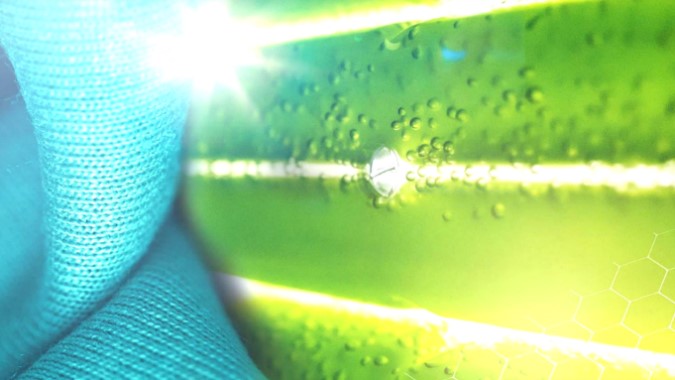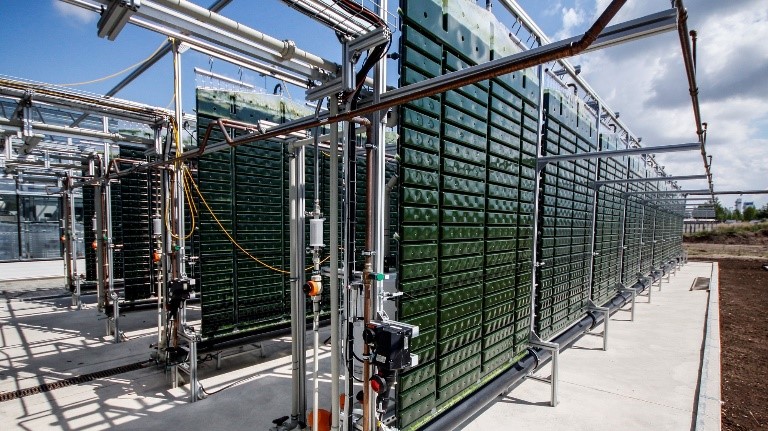The algae biotechnology team has extensive expertise in the cultivation of microalgae, as well as upstream and downstream processes on a pilot scale. Fraunhofer CBP has 40 flat-panel-airlift-photobioreactors with a working volume of up to 180-liter each, which efficiently produces microalgae with a total volume of up to 10 000 liter.
High-value Products from Microalgae
Production of high-value compounds with microalgae
Microalgae play an important role in achieving a responsible and sustainable economy based on renewable resources. Due to their high growth rates and small space requirements, microalgae cultivation requires fewer resources than terrestrial plants.
With specific growth conditions and intelligent engineering, microalgae can be used to produce large quantities of lipids, proteins, dyes, or active pharmaceutical ingredients for the food, feed, pharmaceutical, textile, or chemical industries. By embedding algae biotechnology in the CBP infrastructure, a wide range of options are available for further processing of the biomass containing valuable substances, such as separation, cell disruption or extraction at one location. Here, available facilities offer an excellent bridge between small and industrial scales, while providing flexibility for process optimization.
Algaetex – Sustainable plastics from algae

The Algaetex project aims to answer the question of how it is possible to produce sustainable plastics from microalgae.
The microalgae Chlorella Vulgaris forms fatty acids under nutrient deficiency and light excess, which it stores intracellularly and which accounts for up to 50 percent of its dry mass. Pioneering lighting concepts with LEDs, the development of intelligent process automation and heterotrophic cultivation prior to phototrophic fatty acid formation will increase productivity and make microalgae cultivation and fatty acid formation efficient.
Fatty acids from microalgae are converted to fatty acid methyl ester (FAME) in an acid-catalyzed esterification with methanol. Polymerizing the FAME obtained enables to produce spinnable polymers such as polyester, polyurethane or polyamide, from which fibers and subsequently textiles for clothing are manufactured. A close cooperation with the Institute for Textile Technology at RWTH Aachen University and the Adidas AG makes this research possible.
Through the area- and resource-saving production of the raw materials with microalgae and the development of innovative process solutions for their processing, an overall concept is being developed, which not least represents a major step in the direction of a textile industry without an ecological footprint.
Equipment
Algae biotechnology
Fully automated pilot plant for the cultivation of microalgae (greenhouse and field) based on the flat-panel-airlift-reactor-technology:
- In the greenhouse: five modules with five 6-liter-reactors each, five modules with five 30-liter-reactors each (of which one module is equipped with artificial lighting), three modules with five 180-liter-reactors each - total of 65 reactors with 3.6 m³ capacity
- Outdoor: one module with five 180-liter-reactors, four modules with ten 180-liter-reactors each - total 45 reactors with 8.1 m³ capacity
For the processing of the products from algal biomass, various apparatuses are available at Fraunhofer CBP:
- Plate separator for separation of the culture medium
- High-pressure homogenizer for cell disruption
- Freeze and spray dryers for drying biomass and products
- Pressure reactors for extraction under pressure of valuable substances from microalgae
- Filtration plants for purification of products
- Distillation and rectification plants for solvent recovery
With the existing cultivation and processing facilities, products such as lipids, proteins, dyes, or active pharmaceutical ingredients can be produced on a pilot scale for the food, feed, pharmaceutical, textile, or chemical industries.
- more info on algae biotechnology (igb.fraunhofer.de)
 Fraunhofer Center for Chemical-Biotechnological Processes CBP
Fraunhofer Center for Chemical-Biotechnological Processes CBP









